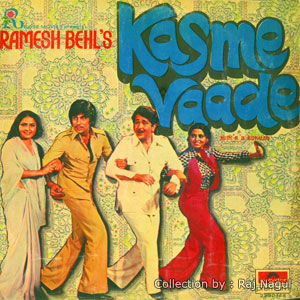Gumsum kyon hai sanam

Film: Kasme Vaade/Bhala Manus (1978)
Producer & Director: Ramesh Bahl
Lyrics: Gulshan Bawra
Singer: Asha Bhosale
The song “Gumsum kyon hai sanam” has perhaps the unique distinction in Indian cinema music to have two dual lives – one each as a Bengali Puja song and a Hindi movie song, and the other in its eventual use in two Hindi movies – Kasme Vaade and Bhala Manus.
The origin of this composition, like many of Pancham’s classics, is in its creation for the annual Bengali Puja festival music release. The original Bengali composition “Jhoom jhoom raat nijhoom,” again as is typical of Pancham’s Puja song, is shorter in duration and less elaborate in music arrangement. In each instance, Asha Bhosle renders the composition – she had become the de facto female (if not the only) vocals for Pancham’s Puja music releases post 1970.
An ever interesting venture is to compare Pancham’s Bengali Puja song with its eventual Hindi movie counterpart (Bengali to Hindi seemed to be the direction of evolution in most cases). It is amazing how Pancham manages to convey so much in the usually under three-and-a-half-minute duration Bengali song. At the same time, the typical Hindi counterpart song, which usually lasts an average of 4 to 5 minutes, is replete with orchestral intricacies, lavish arrangement and many nuances that become indelible with the eventual movie experience. Not sure if Pancham was the wizard of concise or the benefactor of opulence.
With either version, Pancham does not waste any time in setting up the mood – one is instantly treated to romantic prelude music and Asha Bhosle at her sensuous/seductive best. The prelude music starts off with guitar strums supported by percussion triangles (or a similar instrument). Asha’s vocals waft in with her “haan” and “naa” harkats as the remaining instruments join the proceeding.
The key instrument to join is the saxophone – which has a distinct role and place in both compositions. The saxophone plays the role of Asha Bhosle’s partner in the compositions, melding itself to her voice in the prelude and then supporting her on each of the linking lines (for example, “Dard diya hai to”) from the antara to the mukhda. The saxophone also plays an extended role in “Gumsum kyon” in its prelude and second interlude music.
A note regarding Pancham’s music for Rose Movies – from his very first album (The Train) till the last (Indrajeet), Manohari Singh and Maruti Rao Keer have been the essential elements of his music. From arranging the instruments, rhythm and other sections, participation in music sessions, creating individual notations for musicians to contributing as musicians themselves, the duo have always been very identifiable in a Rose Movies soundtrack. Here in this song, the saxophone played by Manohari Singh (and thus Manohari Singh himself) plays the role of Asha Bhosle’s duet partner in the song.
The prelude in “Gumsum kyon” is extended (almost a minute in duration) with the guitars performing extra cycles of the beat. Even Asha Bhosle gets to render additional harkats and the saxophone makes its presence felt from the prelude itself. The highlight of the song is the merging of Asha Bhosle’s voice with the saxophone in the prelude – till both are indistinguishable from the other, and eventually Asha Bhosle’s voice trails off and the saxophone completes her alaap/wail. The saxophone continues along with the guitars – taking over Asha Bhosle’s place till she returns.
Back to my contention of Pancham being the benefactor of opulence when it came to re-creating the Bengali Puja song into Hindi. In “Gumsum kyon,” the embellishments are distinctly evident in the interlude music. For the first interlude, Pancham uses the delectable (and unusual) sounds of the drum sticks hitting the tablas and marimbas to weave memorable fillers and additions. For the second interlude, the saxophone–guitar combination is brought in again to mesmerize.
Kasme Vaade was an extremely popular movie and hugely successful at the box office. It was also the start of lyricist Gulshan Bawra’s journey and life-long partnership with Rose Movies, although he had started working with the Ramesh Behl camp with their earlier presentation Khel Khel Mein.
Gulshan Bawra had the unique talent for shaping his thoughts and words to the requirements of the movie or situation. His words are known for wearing their hearts on their sleeves. However, in “Gumsum kyon,” the situation is from the perspective of the leading lady (played by Neetu Singh) attempting to woo her object of interest (played by Randhir Kapoor) – who has the least interest in her romance. Keeping the mukhda as close to the Bengali original, he matches “Jhoom jhoom raat nijhoom” with “Gumsum kyon hai sanam.”
And finally on the other duality of this composition. The song was originally part of the movie Kasme Vaade. The song was shot and part of the initial prints of the movie – which had a running time of almost 3 hours. It was later edited out of the movie prints. Around the same time, Vishwamitter (who was part of Ramesh Behl’s production office) had launched his debut production Bhala Manus – which had run into budget and schedule issues.
In an instance of his typical generosity, Ramesh Behl offered the complete “Gumsum kyon hai sanam” song (gratis of course) along with the prints of the picturized song to help out the Bhala Manus project. And thus this song got a second lease of life in Bhala Manus. One can obviously make out the Kasme Vaade shot/sequence continuity artifacts including Randhir Kapoor’s post-interval white shirt and trousers, Neetu Singh’s overalls and hairdo, the jeep from the garage in Kasme Vaade, and finally the lush outdoor locations of Kashmir – of course in the rose gardens.
The composition was a tremendous success in all its lives – from the Bengali Puja song to Kasme Vaade to Bhala Manus.
Shashi Rao
panchammagic.org

